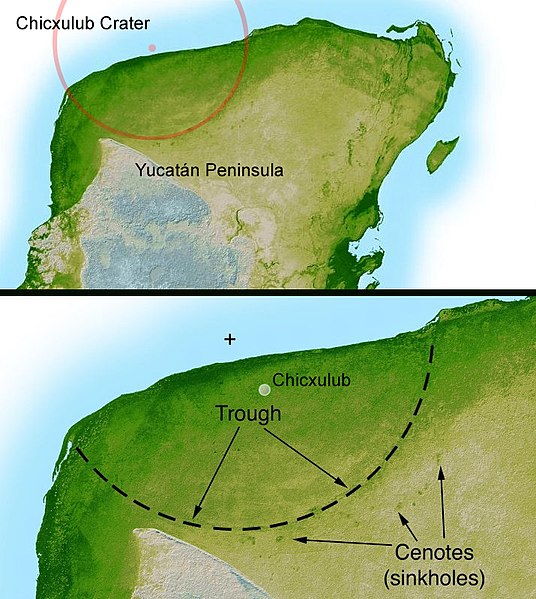Chicxulub Pueblo is a town, and surrounding municipality of the same name, in the Mexican state of Yucatán.
Chicxulub Pueblo
The center of the Chicxulub Impact Crater (approx 21°20'N 89°30'W) is off the Yucatan coast, near Chicxulub Puerto
The Chicxulub crater is an impact crater buried underneath the Yucatán Peninsula in Mexico. Its center is offshore, but the crater is named after the onshore community of Chicxulub Pueblo. It was formed slightly over 66 million years ago when a large meteorite, about ten kilometers in diameter, struck Earth. The crater is estimated to be 200 kilometers in diameter and 20 kilometers in depth. It is the second largest confirmed impact structure on Earth, and the only one whose peak ring is intact and directly accessible for scientific research.
Imaging from NASA's Shuttle Radar Topography Mission STS-99 reveals part of the diameter ring of the crater in the form of a shallow circular trough. Numerous cenotes (sinkholes) cluster around the trough marking the inner crater rim.
Artist's impression of the asteroid slamming into tropical, shallow seas of the sulfur-rich Yucatán Peninsula in what is today Southeast Mexico. The aftermath of the asteroid collision, which occurred approximately 66 million years ago, is believed to have caused the mass extinction of non-avian dinosaurs and many other species on Earth. The impact spewed hundreds of billions of tons of sulfur into the atmosphere, producing a worldwide blackout and freezing temperatures which persisted for at least a decade.
The center of the crater is near Chicxulub Puerto.
Stela in the main square of Chicxulub Puerto commemorating the impact





